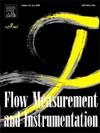Advancing two-phase wet gas flow measurement with Coriolis meters: Optimal sensor orientation and a new model development
IF 2.3
3区 工程技术
Q2 ENGINEERING, MECHANICAL
引用次数: 0
Abstract
In this study, a novel wet gas model was developed based on the internal parameter of a Coriolis prototype to measure two-phase wet gas flow. Additionally, an optimal orientation of the Coriolis sensor was proposed to address challenges in the horizontal wet gas flow. Two Coriolis prototypes– one with a long-bent flow tubes (Type A), and another with short-bent flow tubes (Type B) – were employed to conduct tests in both vertical upward and horizontal pipelines. Different sensor axial angles (0, 40, 90, and 180°) were selected for testing in the horizontal section. Among different orientations (angles), it was found that the 40-degree angle outperforms the other installations in terms of the response proximity and over-reading of gas flow (OR). To understanding the impact of flow pattern on the response, a detailed analysis of different flow patterns in the wet gas was considered. A new correlation was developed between the damping factor of the Coriolis and both XLM and the total mass flow rate, leading to the proposal of a new wet gas model to predict gas and liquid flow rates with acceptable accuracy. In scenarios involving higher Froude numbers and annular flow patterns, which are more likely to occur, the Mean Absolute Percentage Error (MAPE) for the entire range of wetness (0 < XLM < 0.3) is 3.9 % for gas flow rate and 4.3 % for liquid flow rate with an uncertainty of 2.7 %.

推进科氏流量计两相湿气流量测量:优化传感器定位和新模型开发
本文提出了一种基于科里奥利原型内部参数的新型湿气模型,用于测量两相湿气流动。此外,提出了科里奥利传感器的最佳方向,以解决水平湿气流动中的挑战。两个科里奥利原型——一个是长弯曲流管(a型),另一个是短弯曲流管(B型)——被用来在垂直向上和水平管道中进行测试。选择不同的传感器轴向角度(0°、40°、90°和180°)在水平截面进行测试。在不同的定向(角度)中,40度角在响应接近度和气体流量(OR)过读方面优于其他安装。为了了解流型对响应的影响,对湿气中不同的流型进行了详细的分析。在科里奥利阻尼系数和XLM与总质量流量之间建立了新的相关性,从而提出了一种新的湿气模型,可以以可接受的精度预测气液流量。在涉及更高的弗劳德数和更有可能发生的环形流模式的情况下,整个湿度范围(0 <;XLM & lt;0.3)气体流速为3.9%,液体流速为4.3%,不确定度为2.7%。
本文章由计算机程序翻译,如有差异,请以英文原文为准。
求助全文
约1分钟内获得全文
求助全文
来源期刊

Flow Measurement and Instrumentation
工程技术-工程:机械
CiteScore
4.30
自引率
13.60%
发文量
123
审稿时长
6 months
期刊介绍:
Flow Measurement and Instrumentation is dedicated to disseminating the latest research results on all aspects of flow measurement, in both closed conduits and open channels. The design of flow measurement systems involves a wide variety of multidisciplinary activities including modelling the flow sensor, the fluid flow and the sensor/fluid interactions through the use of computation techniques; the development of advanced transducer systems and their associated signal processing and the laboratory and field assessment of the overall system under ideal and disturbed conditions.
FMI is the essential forum for critical information exchange, and contributions are particularly encouraged in the following areas of interest:
Modelling: the application of mathematical and computational modelling to the interaction of fluid dynamics with flowmeters, including flowmeter behaviour, improved flowmeter design and installation problems. Application of CAD/CAE techniques to flowmeter modelling are eligible.
Design and development: the detailed design of the flowmeter head and/or signal processing aspects of novel flowmeters. Emphasis is given to papers identifying new sensor configurations, multisensor flow measurement systems, non-intrusive flow metering techniques and the application of microelectronic techniques in smart or intelligent systems.
Calibration techniques: including descriptions of new or existing calibration facilities and techniques, calibration data from different flowmeter types, and calibration intercomparison data from different laboratories.
Installation effect data: dealing with the effects of non-ideal flow conditions on flowmeters. Papers combining a theoretical understanding of flowmeter behaviour with experimental work are particularly welcome.
 求助内容:
求助内容: 应助结果提醒方式:
应助结果提醒方式:


